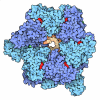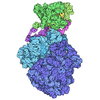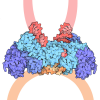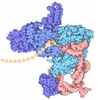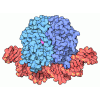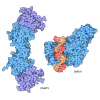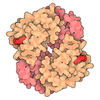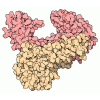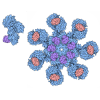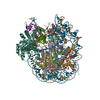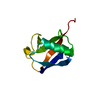[English] 日本語
 Yorodumi
Yorodumi- PDB-9dg3: ncPRC1RYBP Delta-linker mutant bound to singly modified H2AK119Ub... -
+ Open data
Open data
- Basic information
Basic information
| Entry | Database: PDB / ID: 9dg3 | ||||||||||||
|---|---|---|---|---|---|---|---|---|---|---|---|---|---|
| Title | ncPRC1RYBP Delta-linker mutant bound to singly modified H2AK119Ub nucleosome | ||||||||||||
 Components Components |
| ||||||||||||
 Keywords Keywords | NUCLEAR PROTEIN/DNA / DNA complex protein / structural protein / NUCLEAR PROTEIN-DNA complex | ||||||||||||
| Function / homology |  Function and homology information Function and homology informationPcG protein complex / hypothalamus gonadotrophin-releasing hormone neuron development / female meiosis I / positive regulation of protein monoubiquitination / fat pad development / mitochondrion transport along microtubule / female gonad development / seminiferous tubule development / Transcriptional Regulation by E2F6 / RUNX1 interacts with co-factors whose precise effect on RUNX1 targets is not known ...PcG protein complex / hypothalamus gonadotrophin-releasing hormone neuron development / female meiosis I / positive regulation of protein monoubiquitination / fat pad development / mitochondrion transport along microtubule / female gonad development / seminiferous tubule development / Transcriptional Regulation by E2F6 / RUNX1 interacts with co-factors whose precise effect on RUNX1 targets is not known / male meiosis I / positive regulation of intrinsic apoptotic signaling pathway by p53 class mediator / energy homeostasis / regulation of neuron apoptotic process / neuron projection morphogenesis / regulation of proteasomal protein catabolic process / Maturation of protein E / Maturation of protein E / ER Quality Control Compartment (ERQC) / negative regulation of proteasomal ubiquitin-dependent protein catabolic process / Myoclonic epilepsy of Lafora / FLT3 signaling by CBL mutants / Prevention of phagosomal-lysosomal fusion / IRAK2 mediated activation of TAK1 complex / Alpha-protein kinase 1 signaling pathway / Glycogen synthesis / IRAK1 recruits IKK complex / IRAK1 recruits IKK complex upon TLR7/8 or 9 stimulation / Endosomal Sorting Complex Required For Transport (ESCRT) / Membrane binding and targetting of GAG proteins / Negative regulation of FLT3 / Regulation of TBK1, IKKε (IKBKE)-mediated activation of IRF3, IRF7 / PTK6 Regulates RTKs and Their Effectors AKT1 and DOK1 / Regulation of TBK1, IKKε-mediated activation of IRF3, IRF7 upon TLR3 ligation / Constitutive Signaling by NOTCH1 HD Domain Mutants / IRAK2 mediated activation of TAK1 complex upon TLR7/8 or 9 stimulation / NOTCH2 Activation and Transmission of Signal to the Nucleus / TICAM1,TRAF6-dependent induction of TAK1 complex / TICAM1-dependent activation of IRF3/IRF7 / APC/C:Cdc20 mediated degradation of Cyclin B / Downregulation of ERBB4 signaling / Regulation of FZD by ubiquitination / APC-Cdc20 mediated degradation of Nek2A / p75NTR recruits signalling complexes / InlA-mediated entry of Listeria monocytogenes into host cells / TRAF6 mediated IRF7 activation in TLR7/8 or 9 signaling / TRAF6-mediated induction of TAK1 complex within TLR4 complex / Regulation of pyruvate metabolism / NF-kB is activated and signals survival / Regulation of innate immune responses to cytosolic DNA / Downregulation of ERBB2:ERBB3 signaling / Pexophagy / NRIF signals cell death from the nucleus / VLDLR internalisation and degradation / Regulation of PTEN localization / Activated NOTCH1 Transmits Signal to the Nucleus / Regulation of BACH1 activity / Synthesis of active ubiquitin: roles of E1 and E2 enzymes / MAP3K8 (TPL2)-dependent MAPK1/3 activation / Translesion synthesis by REV1 / TICAM1, RIP1-mediated IKK complex recruitment / InlB-mediated entry of Listeria monocytogenes into host cell / Translesion synthesis by POLK / Activation of IRF3, IRF7 mediated by TBK1, IKKε (IKBKE) / Downregulation of TGF-beta receptor signaling / JNK (c-Jun kinases) phosphorylation and activation mediated by activated human TAK1 / Josephin domain DUBs / Translesion synthesis by POLI / Regulation of activated PAK-2p34 by proteasome mediated degradation / Gap-filling DNA repair synthesis and ligation in GG-NER / IKK complex recruitment mediated by RIP1 / positive regulation of protein ubiquitination / PINK1-PRKN Mediated Mitophagy / TGF-beta receptor signaling in EMT (epithelial to mesenchymal transition) / TNFR1-induced NF-kappa-B signaling pathway / Autodegradation of Cdh1 by Cdh1:APC/C / regulation of mitochondrial membrane potential / APC/C:Cdc20 mediated degradation of Securin / TCF dependent signaling in response to WNT / N-glycan trimming in the ER and Calnexin/Calreticulin cycle / Regulation of NF-kappa B signaling / Asymmetric localization of PCP proteins / Ubiquitin-dependent degradation of Cyclin D / activated TAK1 mediates p38 MAPK activation / transcription coregulator activity / SCF-beta-TrCP mediated degradation of Emi1 / NIK-->noncanonical NF-kB signaling / TNFR2 non-canonical NF-kB pathway / AUF1 (hnRNP D0) binds and destabilizes mRNA / Regulation of signaling by CBL / Vpu mediated degradation of CD4 / NOTCH3 Activation and Transmission of Signal to the Nucleus / Negative regulators of DDX58/IFIH1 signaling / Deactivation of the beta-catenin transactivating complex / Assembly of the pre-replicative complex / Ubiquitin-Mediated Degradation of Phosphorylated Cdc25A / Degradation of DVL / Negative regulation of FGFR3 signaling / Fanconi Anemia Pathway / Peroxisomal protein import Similarity search - Function | ||||||||||||
| Biological species | synthetic construct (others)  Homo sapiens (human) Homo sapiens (human) | ||||||||||||
| Method | ELECTRON MICROSCOPY / single particle reconstruction / cryo EM / Resolution: 3.46 Å | ||||||||||||
 Authors Authors | Godinez-Lopez, V. / Valencia-Sanchez, M.I. / Armache, J.P. / Armache, K.-J. | ||||||||||||
| Funding support |  United States, 3items United States, 3items
| ||||||||||||
 Citation Citation |  Journal: Nature / Year: 2024 Journal: Nature / Year: 2024Title: Read-write mechanisms of H2A ubiquitination by Polycomb repressive complex 1. Authors: Victoria Godínez López / Marco Igor Valencia-Sánchez / Stephen Abini-Agbomson / Jonathan F Thomas / Rachel Lee / Pablo De Ioannes / Brian A Sosa / Jean-Paul Armache / Karim-Jean Armache /  Abstract: Epigenetic inheritance of silent chromatin domains is fundamental to cellular memory during embryogenesis, but it must overcome the dilution of repressive histone modifications during DNA replication. ...Epigenetic inheritance of silent chromatin domains is fundamental to cellular memory during embryogenesis, but it must overcome the dilution of repressive histone modifications during DNA replication. One such modification, histone H2A lysine 119 monoubiquitination (H2AK119Ub), needs to be re-established by the Polycomb repressive complex 1 (PRC1) E3 ligase to restore the silent Polycomb domain. However, the exact mechanism behind this restoration remains unknown. Here, combining cryo-electron microscopy (cryo-EM) and functional approaches, we characterize the read-write mechanism of the non-canonical PRC1-containing RYBP (ncPRC1). This mechanism, which functions as a positive-feedback loop in epigenetic regulation, emphasizes the pivotal role of ncPRC1 in restoring H2AK119Ub. We observe an asymmetrical binding of ncPRC1 to H2AK119Ub nucleosomes, guided in part by the N-terminal zinc-finger domain of RYBP binding to residual H2AK119Ub on nascent chromatin. This recognition positions the RING domains of RING1B and BMI1 on the unmodified nucleosome side, enabling recruitment of the E2 enzyme to ubiquitinate H2AK119 within the same nucleosome (intra-nucleosome read-write) or across nucleosomes (inter-nucleosome read-write). Collectively, our findings provide key structural and mechanistic insights into the dynamic interplay of epigenetic regulation, highlighting the significance of ncPRC1 in H2AK119Ub restoration to sustain repressive chromatin domains. | ||||||||||||
| History |
|
- Structure visualization
Structure visualization
| Structure viewer | Molecule:  Molmil Molmil Jmol/JSmol Jmol/JSmol |
|---|
- Downloads & links
Downloads & links
- Download
Download
| PDBx/mmCIF format |  9dg3.cif.gz 9dg3.cif.gz | 342.5 KB | Display |  PDBx/mmCIF format PDBx/mmCIF format |
|---|---|---|---|---|
| PDB format |  pdb9dg3.ent.gz pdb9dg3.ent.gz | 254.7 KB | Display |  PDB format PDB format |
| PDBx/mmJSON format |  9dg3.json.gz 9dg3.json.gz | Tree view |  PDBx/mmJSON format PDBx/mmJSON format | |
| Others |  Other downloads Other downloads |
-Validation report
| Summary document |  9dg3_validation.pdf.gz 9dg3_validation.pdf.gz | 1.3 MB | Display |  wwPDB validaton report wwPDB validaton report |
|---|---|---|---|---|
| Full document |  9dg3_full_validation.pdf.gz 9dg3_full_validation.pdf.gz | 1.3 MB | Display | |
| Data in XML |  9dg3_validation.xml.gz 9dg3_validation.xml.gz | 43.1 KB | Display | |
| Data in CIF |  9dg3_validation.cif.gz 9dg3_validation.cif.gz | 66.6 KB | Display | |
| Arichive directory |  https://data.pdbj.org/pub/pdb/validation_reports/dg/9dg3 https://data.pdbj.org/pub/pdb/validation_reports/dg/9dg3 ftp://data.pdbj.org/pub/pdb/validation_reports/dg/9dg3 ftp://data.pdbj.org/pub/pdb/validation_reports/dg/9dg3 | HTTPS FTP |
-Related structure data
| Related structure data |  46822MC 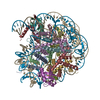 9dbyC 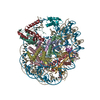 9ddeC 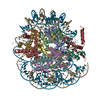 9dggC M: map data used to model this data C: citing same article ( |
|---|---|
| Similar structure data | Similarity search - Function & homology  F&H Search F&H Search |
- Links
Links
- Assembly
Assembly
| Deposited unit | 
|
|---|---|
| 1 |
|
- Components
Components
-Protein , 5 types, 8 molecules AEBFDHMN
| #1: Protein | Mass: 15435.126 Da / Num. of mol.: 2 / Mutation: G103A Source method: isolated from a genetically manipulated source Source: (gene. exp.)  #2: Protein | Mass: 11394.426 Da / Num. of mol.: 2 Source method: isolated from a genetically manipulated source Source: (gene. exp.)  #4: Protein | Mass: 13979.291 Da / Num. of mol.: 2 / Mutation: S33T Source method: isolated from a genetically manipulated source Source: (gene. exp.)  #8: Protein | | Mass: 24863.625 Da / Num. of mol.: 1 Source method: isolated from a genetically manipulated source Source: (gene. exp.)  Homo sapiens (human) / Gene: RYBP, DEDAF, YEAF1 / Production host: Homo sapiens (human) / Gene: RYBP, DEDAF, YEAF1 / Production host:  #9: Protein | | Mass: 8622.922 Da / Num. of mol.: 1 / Mutation: G76C Source method: isolated from a genetically manipulated source Source: (gene. exp.)  Homo sapiens (human) / Gene: UBB / Production host: Homo sapiens (human) / Gene: UBB / Production host:  |
|---|
-Histone H2A type ... , 2 types, 2 molecules CG
| #3: Protein | Mass: 14093.436 Da / Num. of mol.: 1 / Mutation: G100R Source method: isolated from a genetically manipulated source Source: (gene. exp.)  |
|---|---|
| #5: Protein | Mass: 14067.398 Da / Num. of mol.: 1 / Mutation: G100R, K119C Source method: isolated from a genetically manipulated source Source: (gene. exp.)  |
-DNA chain , 2 types, 2 molecules IJ
| #6: DNA chain | Mass: 57982.918 Da / Num. of mol.: 1 Source method: isolated from a genetically manipulated source Source: (gene. exp.) synthetic construct (others) / Production host:  |
|---|---|
| #7: DNA chain | Mass: 57488.551 Da / Num. of mol.: 1 Source method: isolated from a genetically manipulated source Source: (gene. exp.) synthetic construct (others) / Production host:  |
-Non-polymers , 1 types, 1 molecules 
| #10: Chemical | ChemComp-ZN / |
|---|
-Details
| Has ligand of interest | N |
|---|---|
| Has protein modification | N |
-Experimental details
-Experiment
| Experiment | Method: ELECTRON MICROSCOPY |
|---|---|
| EM experiment | Aggregation state: PARTICLE / 3D reconstruction method: single particle reconstruction |
- Sample preparation
Sample preparation
| Component | Name: ncPRC1RYBP Delta-linker mutant bound to singly modified H2AK119Ub nucleosome Type: COMPLEX / Entity ID: #1-#9 / Source: RECOMBINANT |
|---|---|
| Source (natural) | Organism:  Homo sapiens (human) Homo sapiens (human) |
| Source (recombinant) | Organism:  |
| Buffer solution | pH: 7.5 |
| Specimen | Embedding applied: NO / Shadowing applied: NO / Staining applied: NO / Vitrification applied: YES |
| Vitrification | Cryogen name: ETHANE |
- Electron microscopy imaging
Electron microscopy imaging
| Experimental equipment | 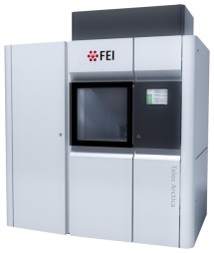 Model: Talos Arctica / Image courtesy: FEI Company |
|---|---|
| Microscopy | Model: FEI TALOS ARCTICA |
| Electron gun | Electron source:  FIELD EMISSION GUN / Accelerating voltage: 200 kV / Illumination mode: OTHER FIELD EMISSION GUN / Accelerating voltage: 200 kV / Illumination mode: OTHER |
| Electron lens | Mode: BRIGHT FIELD / Nominal defocus max: 3500 nm / Nominal defocus min: 800 nm |
| Image recording | Electron dose: 49.6 e/Å2 / Film or detector model: GATAN K3 (6k x 4k) / Num. of real images: 3292 |
- Processing
Processing
| EM software |
| |||||||||||||||||||||||||||||||||||||||||||||||||
|---|---|---|---|---|---|---|---|---|---|---|---|---|---|---|---|---|---|---|---|---|---|---|---|---|---|---|---|---|---|---|---|---|---|---|---|---|---|---|---|---|---|---|---|---|---|---|---|---|---|---|
| CTF correction | Type: PHASE FLIPPING AND AMPLITUDE CORRECTION | |||||||||||||||||||||||||||||||||||||||||||||||||
| Particle selection | Num. of particles selected: 1127632 | |||||||||||||||||||||||||||||||||||||||||||||||||
| 3D reconstruction | Resolution: 3.46 Å / Resolution method: FSC 0.143 CUT-OFF / Num. of particles: 23464 / Symmetry type: POINT | |||||||||||||||||||||||||||||||||||||||||||||||||
| Atomic model building |
|
 Movie
Movie Controller
Controller















 PDBj
PDBj

